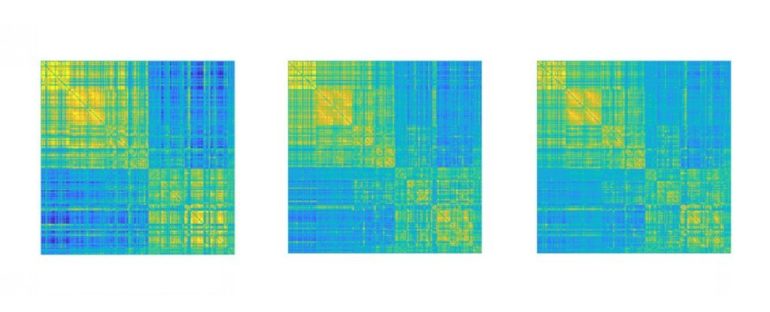The patterns of activity produced by our brains are unique. They’re so unique that we can use brain connectivity maps to identify individuals just as reliably as fingerprints.
“An individual’s functional brain connectivity profile is both unique and reliable, similar to a fingerprint, and it is possible, with near-perfect accuracy in many cases, to identify an individual among a large group of subjects solely on the basis of her or his connectivity profile,” neuroscientist and lead researcher Dimitri Van De Ville and team write in their paper.
Yale University researchers discovered this back in 2015, and now a team from the Swiss Federal Institute of Technology in Lausanne has examined how these patterns change over time to try and understand when brain activity patterns become unique and identifiable.
The researchers turned the information from functional magnetic resonance imaging (fMRI) scans measuring the brain activity of 100 unrelated people at rest into colorful graphical summaries to build an atlas that considered 419 points in our brains.
“All the information we need is in these graphs, that are commonly known as ‘functional brain connectomes’,” explained neuroscientist Enrico Amico.
“The connectome is a map of the neural network. They inform us about what subjects were doing during their MRI scan – if they were resting or performing some other tasks, for example. Our connectomes change based on what activity was being carried out and what parts of the brain were being used.”
Functional brain connectome map. (Enrico Amico)
The researchers found that while longer time scales allowed for better differentiation between individuals, 1 minute and 40 seconds was all it took for enough data to be collected for reliable identification.
But the most identifiable moment of the scans was not locked to a particular time point, which may have to do with how our brains naturally cycle their activity, the team suspect.
“We realized that the information needed for a brain fingerprint to unfold could be obtained over very short time periods,” said Amico. “There’s no need for an MRI that measures brain activity for five minutes, for example. Shorter time scales could work, too.”
Shorter scans picked up more sensory activity, such as eye movements, but the unique information from more complex cognitive functions out of the frontal cortex began to emerge after a more extended period. These include things such as language, awareness, working memory, and social cognition – suggesting that specific brain networks are functioning at different time scales.
“This work also opens the avenue of relating functional brain fingerprints with the underlying structural architecture,” the researchers write, noting the two distinct time scales of the brain maps they observed seem to align with underlying genetic and behavioral gradients.
If this signature of functionality defines our identity on some deeper level, it’s natural to ask what kind of conditions might cause this to break down. Could Alzheimer’s disease, for example, rob our brains of its neurological fingerprint?
“Based on my initial findings, it seems that the features that make a brain fingerprint unique steadily disappear as the disease progresses,” says Amico. “It gets harder to identify people based on their connectomes. It’s as if a person with Alzheimer’s loses his or her brain identity.”
There’s still a lot to test out, like if the chosen points for the brain atlas are reliable. Comparing the resting state maps with those constructed when individuals perform a task or using different scanning techniques could tell us more, the researchers suggest.
“This is just another little step towards understanding what makes our brains unique,” says Amico. “The opportunities that this insight might create are limitless.”
This research was published in Science Advances.



